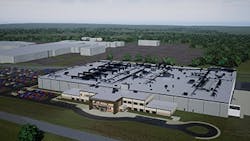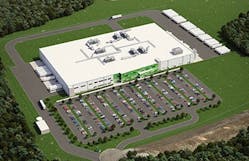Like many aspects of the U.S. economy, capital expenditures in the food and beverage industry tumbled last year into the ditch known as the pandemic. But the industry is getting ready to climb back out.
Big food processors had to scale back plans to build, renovate, add lines or generally make big improvements, as the pandemic forced them to concentrate on making necessary adjustments to their current business. But now they are preparing for the economic boost expected as vaccinations drive down the pandemic.
Of the 31 publicly traded major food and beverage companies in this year’s Food Processing list of capital projects, 23 spent less on capital projects in 2020 than they had budgeted. But for 2021, all but four of 31 plan to spend more. Overall, the companies we looked at plan to spend 13% more on capital projects in 2021 than in 2020.
That trend mirrors what’s going on with American manufacturing as a whole. According to Melius Research, industrial firms of all types that reported results in the first half of 2020 predict a 20% increase in capital expenditures.
The pandemic put many projects on hold, but they’re coming back on board, says Todd Miller, senior director of safety at Dennis Group. “We’re seeing food and beverage processors starting to greenlight major capital expansion projects that were delayed last year,” he says.
One effect of the pandemic has been to make companies at least temporarily favor renovation or expansion over new construction. Of the 35 sites in our list of plant construction projects, only nine were new plants, compared with 14 last year.
“We are seeing increased investment in sustaining and increasing production versus building new facilities,” says Robert Summers, senior project manager for engineering at Knobelsdorff.
Although the pandemic suppressed a lot of capital spending, it also created some opportunities for projects, as companies struggled to adjust to new conditions, says Tyler Cundiff, president for food and beverage markets at Gray Inc.
“From our perspective, and likely [that of] many of our customers, the pandemic itself and the resulting disruptions have sparked the need for a variety of new capital spend projects in this industry,” Cundiff says. “The ongoing global recovery and the recovery of other harder-hit markets should only fuel a capital spending trend that is already in full swing.”
Keeping up with change
One of the biggest and best-known effects of the pandemic was a switch from foodservice to retail, as consumers avoided restaurants. That led some processors to reconfigure lines, Miller says.
“Manufacturers who catered to both foodservice and retail clients transitioned capacity over to their retail lines, and in some cases had to retrofit lines to accommodate new products or packaging formats,” he says.
In addition, certain products got enough of a boost from the pandemic to require capital spending by some processors to keep up with demand.
“Even as some sectors in food saw contraction, others had unexpected booms,” Miller says. “According to Nielsen, oat milk, yeast, and meat alternative products saw the largest increase in dollar sales in a 31-week period since March 2020, spurring many expansion projects both internally at their own facilities and also with co-manufacturers.”
One such boom was in pet food, reflecting a big increase in pet adoptions by bored or lonely families or individuals during the pandemic. According to an organization that tracks shelter and rescue animal activity, adoptions of such animals increased 15% in 2020 over last year.
Of the top four projects, three are new or renovated pet plants for Nestlé Purina,totaling $1.5 billion. Mars Petcare and Simmons Pet Food are also expanding or renovating plants.
The increased demand for pet food is likely to last, since most pets will become long-term additions to households. Plant-based analogues for meat, dairy and other proteins form another sector likely to attract post-pandemic investment, as are alternative alcoholic drinks like hard seltzers.
“There’s just a lot of exciting things going on in the food space right now, as our tastes and preferences as consumers are changing,” says Jason Robertson, food & beverage market director at CRB Group.
More generally, the foodservice sector is poised to come roaring back post-pandemic, as consumers start pouring into restaurants and other establishments. That part of the recovery will probably spur new projects, or at least get existing ones back on track.
One of the biggest projects in America, a $300 million potato-processing plant for McCain Foods in Othello, Wash., was paused from April to September due to the pandemic. The problem was that the pandemic suppressed demand for french fries to the point where the project was temporarily unneeded.
Building blocks
When major projects have stalled or delayed during the pandemic, temporary lack of demand for the products made by those plants is the most common reason, observers say. However, the pandemic has created certain practical challenges for both builders and their clients.
One of these is higher steel prices, which affects both construction materials and plant equipment. Steel prices are higher now than they have been since 2008, Miller says. There are various ways to protect against this: “Selecting alternative materials and finishes, pre-purchasing steel, or ensuring adequate budget contingency is allocated to guard against rising prices are a few ways companies are hedging against rising prices.” He also notes that rising steel prices are a harbinger of an economic rebound.
This bacon plant for Clemens Food Group in Hatfield, Pa., is scheduled to be completed in 2024. Image: Gray
Operational challenges on job sites include “navigating a patchwork of travel restrictions, which varied state to state in the U.S and country to country around the world,” Miller says. These include requirements to quarantine workers as needed and to restrict the number of people on a job site. In addition, suppliers in Europe and Asia, which instituted lockdowns earlier than the U.S., were hard-pressed to deliver supplies like construction materials and electrical components.
But these challenges are being overcome, building firms say. Actual construction has encountered some bumps but has not been excessively delayed or affected.
“The pandemic caused a short delay for a few significant projects during the summer months but [they] have since restarted,” Cundiff says. “Some of the delays in project approvals were due to uncertainties in the supply chain.” In addition, he says, some of the major pandemic-related delays to construction were actually in the planning stages, as travel restrictions prohibited project teams from meeting face-to-face; teams had to get used to doing everything online.
There also were slower procurement and engineering cycles, with much of the workforce still remote, and the situation can also delay the installation and startup of equipment. But builders have been able to adapt in terms of their execution, Cundiff says. “Initially, the pandemic was a shock to existing processes. However, we have become even more agile and flexible to accommodate the new normal.”
Robertson agrees that most of the construction-related delays he’s seen have been because the pandemic affected the customer’s plans, not due to any interruption of the construction process.
“We’ve had a few instances, as you can imagine, with some of our projects where a slight pause in the construction activities on site [occurred] because of exposure,” Robertson says. Some quick cleaning and contract tracing took care of the problem, and no sites were shut down for “more than a day or so,” he says.
Flexibility needed
This meat-processing facility in North Kingstown, R.I., which came on line last year, is operated by Cargill and owned by a unit of retailer Ahold Delhaize. Photo: Ahold Delhaize via Dennis Group
The priorities of companies building or renovating plants haven’t exactly been changed by the pandemic, but some of them have been intensified, with more of an emphasis on flexibility. This isn’t surprising, since one of the biggest problems for the industry during the pandemic was having to shift abruptly between products and packaging formats.
Cundiff mentions that some of the biggest priorities among Gray’s food & beverage customers have been speed to market; automation, especially through artificial intelligence and robotics; availability of cold storage space; manufacturing redundancy, and manufacturing consolidation. “They also require flexible design concepts to meet ever-changing product and market demands,” he says.
Flexibility has become more important in the face of the pandemic, with many processors having to switch quickly between products, ramping up some SKUs while scaling back or eliminating others. It will continue to be important as they cope with the pandemic’s end, as many consumer preferences shift back to previous patterns.
One of the easiest, though not cheapest, ways to confer flexibility is simply to leave enough room to grow. Robertson referred to a project CRB did in the past fiscal year, where the owners have enough extra space for a new production line if it’s needed for future production.
“So I think owners have to think about that,” Robertson says “Although there’s that cost of construction and capital that you deploy to [leave room], it just offers a lot of flexibility to have utilities ready so you can move on a dime.”
What’s to come?
Of course, the pandemic hasn’t gone away yet; experts still aren’t sure how much more suffering the world will have to endure. On top of which, there’s a big, fat shadow hovering wherever decisions are being made on future capital projects: Is there going to be a future pandemic, and if so, what should be done to prepare for it?
When food companies have reconfigured or altered production lines in response to the pandemic, it has mostly been in a reactive way, working within the space at hand to install barriers or take other measures. That may continue, Cundiff says. “Further separation and increased automation in consideration with worker flow and workspaces are quickly becoming permanent factors for manufacturing operations.”
Companies planning to build a new space have to decide whether to accommodate requirements like social distancing in case it’s required by another pandemic.
“As we approach one year of living with COVID-19, it's clear that companies are starting to consider capital expenditures for more long-term solutions since the disease could be endemic,” Miller says. “Companies also recognize that in global supply chains where people and materials move constantly, outbreaks of new pathogens are increasingly likely.”
Some processors found themselves having to reconfigure or improve lines during the pandemic to meet demand. Photo: Glossy Productions via Dennis Group
Many plants already feature restrictions on personnel flow, for example between sanitary and less-sanitary areas. The pandemic has led many companies to reconfigure flow to allow temperature scanning or thermal imaging. Future designs should also discourage mingling among employees, Miller says. “Common spaces, break areas and workstations are all spaces that are being evaluated and reconfigured to promote more distance between workers as well as to control the flow of personnel.”
In addition, the pandemic has brought a new emphasis to ventilation, with HVAC equipment makers researching how best to filter airborne droplets – COVID’s primary source of transmission – out of the air.
Probably the most important large-scale initiative to deal with any future pandemics is something of an industry imperative anyway: automation. It’s the only viable long-term strategy for establishing greater distance between workers, in the same space, while maintaining the same output.
“Many companies are taking a different view of automation and robotics projects as labor shortages and worker health concerns are forcing manufacturers to consider the impact of the pandemic beyond the traditional ROI (return on investment) hurdles,” says Todd Allsup, divisional vice president for corporate sales at Stellar.
Miller believes the same thing: “Currently, companies are investing in more long-term, permanent design changes to automated lines that will improve efficiencies while addressing the need for continued spacing of employees and flexibility with products.”
With the end of the pandemic at least theoretically approaching, America is eager to shake off its shackles – and the food industry will be there to accommodate it.
“I’m really optimistic that the food business, in talking with many in the industry, is going to be pretty strong for at least the next 24-plus months,” Robertson says. “I think the future is bright in the food industry.”





